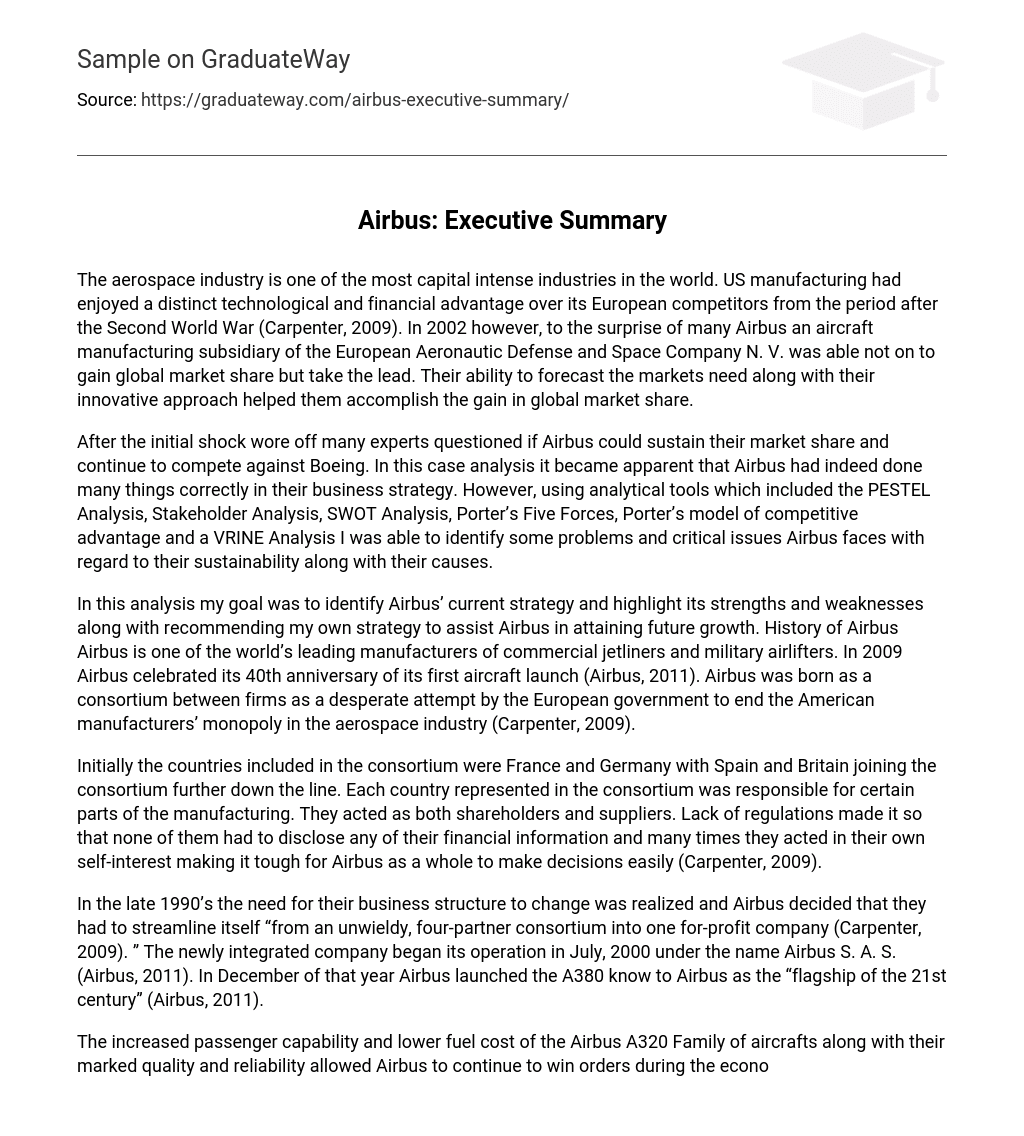Carpenter (2009) states that the aerospace industry needs a large amount of capital. After World War II, European competitors were at a disadvantage compared to US manufacturing. However, in 2002, Airbus, a subsidiary of the European Aeronautic Defense and Space Company N.V., not only gained global market share but also surpassed its rivals. This achievement was credited to Airbus’s accurate prediction of market demands and their innovative strategies.
Following the initial shock, concerns arose regarding Airbus’ ability to sustain its market share and compete with Boeing. Further examination revealed that Airbus had effectively implemented various elements of their business strategy. Nonetheless, through the utilization of analytical tools such as PESTEL Analysis, Stakeholder Analysis, SWOT Analysis, Porter’s Five Forces, Porter’s model of competitive advantage, and a VRINE Analysis, specific challenges and significant matters requiring attention for Airbus’ long-term expansion were identified.
Regarding this analysis, my objective was to identify and assess Airbus’ current strategy, while also identifying its strengths and weaknesses. Additionally, I aim to propose my own strategy to support Airbus in achieving future growth. Let’s explore the history of Airbus – it is recognized as a leading manufacturer of commercial jetliners and military airlifters. In 2009, Airbus commemorated the 40th anniversary of its first aircraft launch (Airbus, 2011). Notably, Airbus emerged as a consortium between firms, serving as a crucial initiative by the European government to challenge the aerospace industry monopoly held by American manufacturers (Carpenter, 2009).
At first, France and Germany were part of the consortium, later joined by Spain and Britain. Each country had specific manufacturing responsibilities and served as both shareholders and suppliers. The absence of regulations allowed them to withhold financial information, often prioritizing their own interests. Consequently, Airbus faced challenges in making decisions collectively (Carpenter, 2009).
In the late 1990’s, Airbus acknowledged the need to change their business structure. They decided to transition from a four-partner consortium into one profitable company (Carpenter, 2009). As a result, Airbus S.A.S. was established and began operations in July 2000 (Airbus, 2011). In December of that year, Airbus introduced the A380, commonly known as the flagship aircraft of the 21st century (Airbus, 2011).
Despite facing economic difficulties and being affected by the September 11th attacks, Airbus managed to achieve success in securing orders. This accomplishment can be attributed to the A320 Family aircraft’s superior passenger capacity and cost-effective fuel consumption. The company primarily focuses on fulfilling the specific needs of airlines and operators by manufacturing advanced and comprehensive aircraft while providing exceptional customer service. Their ultimate objective is to ensure punctual delivery, cost efficiency, and high quality. Safety remains a top priority for Airbus throughout all stages of aircraft design, construction, and performance. They continuously strive to uphold strict standards as they recognize their customers’ demand for excellence. As of 2010, Airbus held a global market share of 52%.
Although Airbus has utilized their strengths and opportunities thus far to achieve success, they must also analyze potential threats and weaknesses in order to ensure future success. The aircraft industry is a significant sector both domestically and globally. In 2008, the export of large civil aircrafts generated $31.3 billion, making it the largest category of manufactured products in the United States (Anderson, 2009).
Since 2007, the global market for large civil aircrafts has been dominated by Airbus and its competitor Boeing (Anderson, 2009). However, despite Porter’s Five Forces suggesting a low threat of new entrants, Airbus’ sustainability is now in doubt as three new competitors have recently announced their plans to directly compete in the large civil aircraft market. These competitors are Commercial Aircraft Company of China, Sukhoi Civil Aircraft Company from Russia, and Bombardier from Canada (Anderson, 2009).
According to Airbus, their plans for a new version may not be launched until 2020, giving competitors an advantage. This delay is expected to last for another ten to fifteen years (Anderson, 2009). Another obstacle to sustainability is the rising costs of jet fuel. The turmoil in Libya and increasing oil prices have led to warnings that the production and usage of aircraft could incur significant additional costs. As a result, airlines may reduce their orders and face higher manufacturing expenses.





